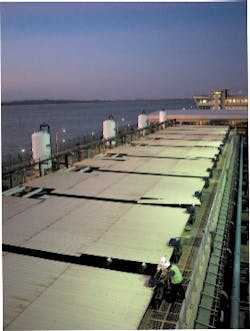Overcoming the global barriers to water reuse
A six-part roundtable debate attempted to help the industry understand the barriers to reusing water. Australian contributors showed how they had to convince people they were experiencing climate change, not drought. Cindy Wallis-Lage highlights what was discussed in the series and in particular, the final debate in Singapore.
Water reuse faces numerous global barriers. These include overcoming public perception due to a lack of public education; pricing the resource while taking into account the related costs and other economic factors; tackling regulatory challenges; and finding sustainable answers appropriate to a particular situation. Those were some of the key findings from a reuse roundtable that Black & Veatch held at the Singapore International Water Week (SIWW) conference in June.
This dialogue was the sixth and last in a series of conversations that took place globally over the last year. About a dozen water and wastewater experts, industry leaders and global trade association representatives from Singapore, Israel, Saudi Arabia, Australia, India and the United States were invited to take part in the SIWW roundtable, which focused on the question: "How do we overcome barriers to reuse as part of an integrated water portfolio?"
Professor Robert Glennon, author of Unquenchable: America's Water Crisis and What to Do About It, opened the final reuse roundtable at SIWW with a provocative keynote address to spark interest and debate. He had also opened the first in the series at the annual Water Environment Federation conference (WEFTEC), which took place last October in Orlando, Florida.
Other dialogues were held during the Association of Metropolitan Water Agencies (AMWA) conference in January in Washington, D.C.; at the Ozwater conference in March in Brisbane, Australia; at the Global Water Intelligence conference in April in Paris, France; and at the American Water Works Association conference (ACE10) earlier in June in Chicago.
The goal of the series was to help water and wastewater industry leaders understand what needs to be done to move forward with reuse.
Supply and demand considerations
In his opening address in Singapore, Glennon speaks about the steady upward trend in overall water usage in the United States, particularly with its growing population. "It's a basic problem of supply and demand, and the supply is finite," he explains. "We're drinking the same water as the dinosaurs drank, and that's the problem."
He uses the metaphor of a milkshake glass with too many straws in it to reinforce the fact that the supply of water is finite but the demands are not. This situation, he says, is not sustainable; and that's why America finds itself now in the midst of a severe water crisis nationwide. "We can't all be putting new straws in the glass," he says. "The government has a stewardship obligation to protect the public resources."
Participants generally agree that the metaphor is valid. One panelist in particular points out that the problems arise when a government forsakes or mismanages that stewardship obligation or doesn't have the right infrastructure in place to accommodate more straws.
Climate variability — with more droughts and stronger, more intense storms — also threatens the supply of water, as one panelist comments: "One of the drivers behind the supply threats is the uncertainty of global climate change." An Australian participant agrees and says that the community had to be brought on board to believe that they weren't just experiencing a short-term drought but actual climate change.
"Pollution is another threat to our water supply," Professor Glennon says. "In America the pollution of our water is from industrial contamination and agricultural runoff, not so much from municipal waste."
When new, clean supplies of water are needed, participants recommended developing a diverse portfolio of water supply options that includes alternatives appropriate to the local environment, such as reclaimed water. "In poorer countries without access to safe drinking water," a panelist from India explains, "water reuse is not only a concept but an absolute necessity."
Public perception, education and outreach
When water reuse isn't a necessity, participants say, it's not easy to overcome the barrier of public acceptance. "Of all the barriers that Professor Glennon pointed out, the 'yuck' factor doesn't seem to go away," says a participant from Australia. "We can say, 'Look at the Mississippi' or 'Look at the Thames' and explain that we all live downstream. But the public still thinks that's somebody else's issue."
It's especially difficult to persuade the public that adding recycled water to increase the water supply is not simply a mechanism to facilitate growth, according to a panelist: "People are not stupid; if it looks as though the only reason to do this is so that the mayor and city council can rubber stamp each proposal for a new subdivision, then you're not going to get buy-in from the community."
To overcome that barrier, public education and outreach are critical to the success of a reuse scheme. "You better be prepared to have scores of meetings that educate the public about what kind of advanced treatment processes you intend to use beyond conventional ones, and you better be able to persuade them that recycled water is safe," a panelist says.
One key to public acceptance is to combine recycled water with natural systems, say participants. Gallop, New Mexico; McAllen, Texas, Denver, Colorado; Phoenix, Arizona; and Orange County, California, were cited as U.S. best practice examples of recharge and recovery.
Even in Saudi Arabia and India, Islam allows for indirect reuse when the water has already been returned to the hydrologic cycle.
Participants also pointed to the work done by Singapore's national water agency PUB, through its Active, Beautiful and Clean Waters Programme and the NEWater Visitors Center as a best practice. One of the Singapore participants explained that they showed ministers and politicians drinking the NEWater and then give away free bottles of NEWater to build the grassroots appeal.
"We've got to go through the same exercise that Singapore went through," an Australian panelist says. "We need to bring the community along and try to get them to understand our position, so we'll have to step cautiously into reuse."
In order to step cautiously into reuse, many communities are introducing more "palatable" recycling programs, like using gray water for landscaping or toilet flushing or harvesting rain water from rooftops or parking lots. One participant pointed out how "re-infrastructure" programs that deal with storm water by slowing its movement can help ensure that storm water becomes a valuable resource.
Other conservation measures include household solutions like low-flow showerheads and toilets. One participant mentioned a large-scale trial in Sydney, Australia, for smart meters to track household water use. "The theory is that the sooner we can advise people of what their water use is and what the pricing impacts are, the more likely that they will be careful in the way they conserve," he explained.
Good conservation habits can reduce demand for water overall, which could lessen the need for reuse, but there is an economic impact. As one panelist observes: "People conserve water and then what? Then the utilities are short of money. So what do you do? You raise their rates." This creates a pricing paradox in the eyes of the customer.
Professor Robert Glennon is the Morris K. Udall Professor of Law and Public Policy in the Rogers College of Law at the University of Arizona. He's the recipient of two National Science Foundation grants and serves as Water Policy Adviser to Pima County and as a commentator and analyst for various television and radio programs. Dr. Glennon's best known publication is Water Follies: Groundwater Pumping and the Fate of America's Fresh Waters, which was published in 2002 and received accolades from Scientific American, Washington Post, and New York Review. His new book is Unquenchable: America's Water Crisis and What to Do About It, which was published about a year ago. Since then he's been a guest on a variety of television and radio programs and has delivered presentations on water internationally.Pricing considerations
Price signals can encourage conservation. As Professor Glennon points out: "You can't talk about any sensible reuse of water without coming to terms with the fact that the basic supply is underpriced or not priced at all in some places."
He talks about how some big cities have flat rates that only cover the cost of servicing, and one third of American cities have decreasing block rates. "This is not a sensible way to encourage water conservation; we need to price water appropriately."
One participant agrees, saying: "Fundamentally it requires effective pricing at the household level. But ironically, the people who pay the highest price for water proportionately are the poorest people."
"Some people won't notice if the price of water is five times what it is today, so raising the price for water won't drive the level of conservation required. Still, appropriate pricing is absolutely paramount going forward," another says.
As one participant points out: "Typically reclaimed water costs are much higher than conventional supplies. If you want to do advanced treatment because you're thinking about either direct potable use or indirect potable use, that drives prices up further, so that's certainly one of the barriers." Another participant agrees: "If it's a straight recycled water solution, then unless I'm directed by government to implement that, I have to get full cost recovery from the end user, which then puts reuse in a very poor competitive position."
What goes into pricing varies by location. "Adding an additional price that reflects a value has always been a source of debate," a panelist explains. "Some in fact consider that to be a tax, so you have to be sure that it's not just seen to be a money grab." "In a lot of Australian cities, prices reflect the cost of delivering the product, plus environmental approval costs and other services," another participant says. "But Australia has independent price regulators in nearly all of our states and territories, which removes much of the political process of determining prices for water and water services and is an advantage over the U.S. in generating greater recycled water."
Regulatory considerations
Government and regulatory structures can be barriers to integrating reuse into water portfolios. To overcome that barrier, the right regulatory framework for reuse has to be put into place, the roundtable say.
Water utilities in Australia for drinking water and wastewater are combined, which creates another advantage for overcoming barriers to reuse. "The fact that they are integrated gives them more scale and a greater capacity to take on complex water projects," according to an Australian panelist. "We have different sets of national guidelines dealing with recycled water, whether it's for recycled water for aquifer storage or for drinking."
Setting guidelines for reuse is simpler in Singapore than in the United States because there is only a single level of government, not separate federal and state agencies, according to one Singaporean panelist.
"The drivers behind reuse in the United States have been the Clean Water Act and the Drinking Water Act," a U.S. participant explains.
Professor Glennon adds that those acts come from two separate committees in the House and the Senate, which creates a political barrier.
"Until that's fixed, we can't have one set of legislation that deals with all aspects of water," he says. "We desperately need a national water policy to aim at some of the barriers we've been talking about."
In addition, the regulatory missions of local agencies are often conflicting, Professor Glennon points out: "Typically you've got a water agency that wants the public to conserve and reuse water. Then on the second corner of this three-legged stool, you've got the water quality agency that's concerned about what the quality of this effluent. Then you've got the public utility commission, and they want water to be as cheap as possible. So if you can't put these three together; it won't work."
Sustainability aspects
Institutional barriers to water reuse are more of a concern than technological barriers, participants believed. "The technology in place is reliable and capable of increasing our available water supply whether in the form of desalination or recycled water," a panelist says.
"We have a host of ingenious and indigenous ways of reducing the water consumption by as much as two-thirds," the participant from India addd. "It's a combination of the engineering solutions plus reuse and recycle schemes."
Engineering solutions like desalination can be part of the solution, one participant adds, but high energy costs can be prohibitive: "Desalination is not a silver bullet because it's very costly and creates the vexing environmental challenge of what do you do with the concentrated brine that's left over once you've completed the desalination process," he said. "Also it uses enormous amounts of energy, which then reinforces the water/energy problem."
Anoter panelist adds: "The other issue that has also struck us in Australia is the relationship with power — not just how much water that power uses, but their requirement for 100% reliability. If you run out of water, you run out of power at the same time. We've got to make sure the public understands that factor more fully."
Helping the consumer understand the nexus of water and energy can be a challenge. "In California 19% of the energy consumption is associated with the movement and use of water, and a significant portion of that is for pumping," one U.S. participant said. "But of that 19%, 75% is associated with the end user. So what people do in their own homes will have a significant impact in terms of energy reduction."
Another Australian participant agrees, saying "The low hanging fruit in the total urban water and energy nexus resides in the households. In Australia about 30% of all household energy goes to heating water."
One U.S. participant cited a best-practice case in Arizona, where the Palo Verde Nuclear Plant uses effluent and reclaimed water from the city of Phoenix to run its cooling system.
Conclusion
The reuse roundtable ends after 90 minutes of lively discussion and debate and a Q&A session with the journalists in attendance. No "perfect" answer arose in this SIWW discussion. Many best practice examples are cited about utility leaders who have already overcome a wide range of barriers to reuse in an integrated portfolio. "It's not one size fits all," a panelist says, "Everything needs to be contextualised or localised before it can be applied."
In Professor Glennon's words: "None of the barriers mentioned are insurmountable barriers. Reusing water is so obviously the right thing to do; it is so obviously what we must do going forward that I'm very optimistic we can do this.
"But it will take dialogue and education, political understanding and strong commitment to take these next sensible steps," he adds.
Author's note:Cindy Wallis-Lage is senior vice president, executive managing director of technical solutions for Black & Veatch.
More Water & WasteWater International Current Issue Articles
More Water & WasteWater International Archives Issue Articles




